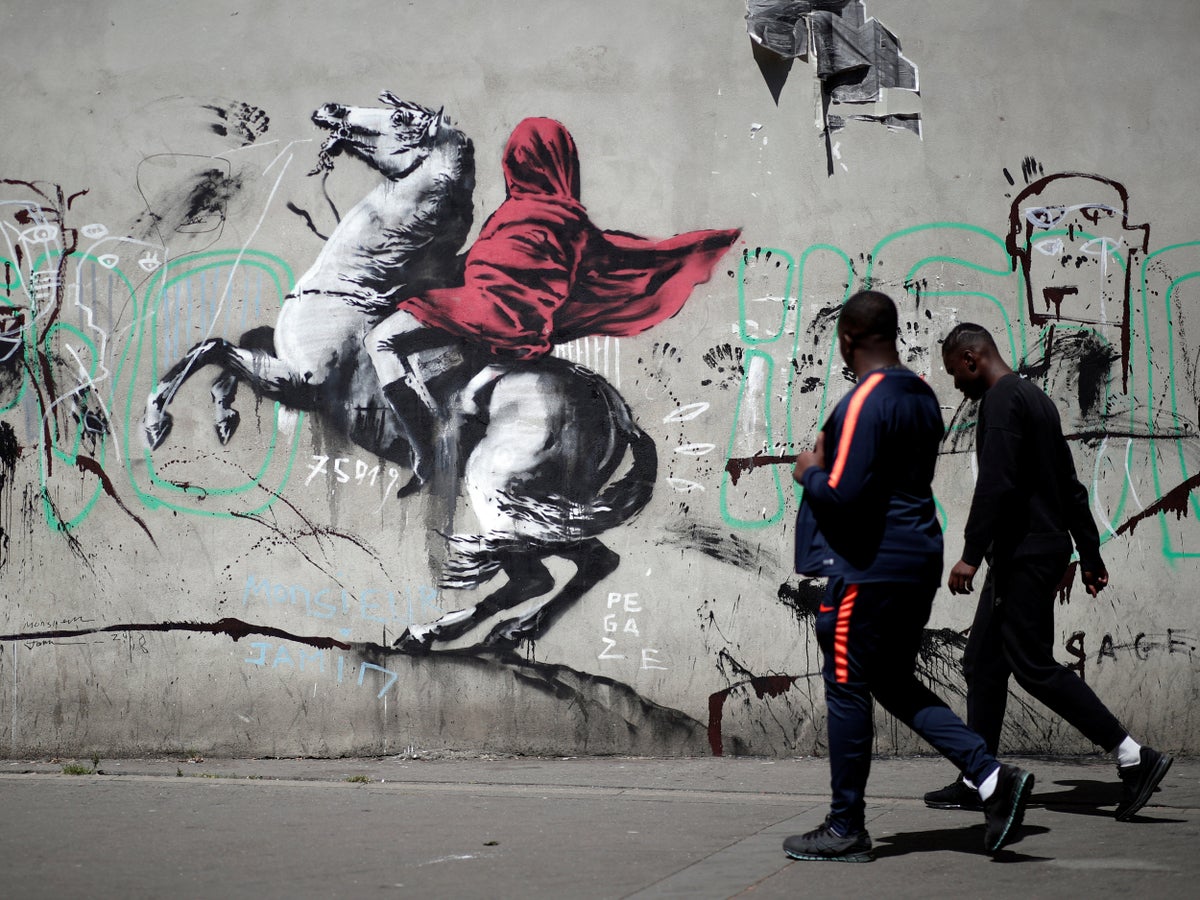Curiosity piqued? The enigmatic world of street art holds a cryptic figure at its core Banksy. This mysterious artist, shrouded in anonymity, has captured the imagination of art enthusiasts, rebels, and admirers worldwide. Who is Banksy, the clandestine creator of thought-provoking, subversive artworks that adorn urban landscapes?
This journey into the world of anonymity, creativity, and rebellion will reveal the secrets behind Banksy’s iconic works and the compelling narrative that surrounds this elusive artist. Prepare to embark on a captivating exploration of the mind behind the stencils, murals, and social commentary that continue to defy conventions and ignite curiosity.
Banksy is a pseudonymous England-based street artist, political activist, and film director, whose real identity remains unknown. He is known for his subversive and often humorous artwork that critiques social and political issues. His works of political and social commentary have been featured on streets, walls, and bridges of cities throughout the world.
The importance of Banksy in contemporary art cannot be overstated. He has captured the attention of the public and the art world alike with his thought-provoking and often controversial pieces. He has become one of the most well-known and sought-after street artists of our time, with his works fetching high prices at auction and appearing in exhibitions worldwide.
For Banksy’s Short Bio Visit Here
Who is Banksy?
The Mysterious Artist: The Enigma behind Banksy’s Identity
Despite being a prominent figures in the art world, very little is known about the true identity of Banksy. He has maintained strict anonymity, with his face and real name kept secret from the public. This has only added to the mystique and allure of Banksy, as people continue to speculate about who the artist might be.

There have been numerous theories about Banksy’s identity, with some people suggesting that he is a collective of artists, while others believe that he is a single person. Despite the speculation, Banksy has remained tight-lipped about his identity, and it remains one of the art world’s greatest mysteries.
The importance of anonymity in Banksy’s work cannot be overstated. It allows him to comment on society and politics without fear of retribution, and it also adds to the impact of his pieces. By keeping his identity a secret, Banksy has created an aura of mystery and intrigue around his work, which has only served to heighten its impact and reach.
Banksy’s Artistic Style: The Power of Stenciling and Humor
Banksy’s signature style of street art is characterized by the use of stencils and distinctive dark humor. His works often feature political and social commentary, with an underlying message that is both thought-provoking and often controversial. He uses his art as a medium to challenge societal norms and raise awareness about important issues such as war, poverty, and social justice.
One of the hallmarks of Banksy’s style is the use of bold, graphic images that are both visually striking and culturally relevant. He uses a variety of techniques, including spray paint, stickers, and posters, to create works that are both accessible and thought-provoking.
Some of Banksy’s most notable works include “Girl with Balloon,” “Flower Thrower,” and “Devolved Parliament.” These pieces have become iconic in their own right, and they serve as powerful examples of Banksy’s ability to use his art to comment on the world around him.
Banksy’s Life and Theories about his identity
Banksy is one of the most enigmatic and controversial street artists of our time. Despite the fact that he has been active for over two decades, his true identity remains unknown. This has led to numerous theories and speculations about who Banksy might be.
Additionally, we will examine the most popular theories about Banksy’s identity, the evidence supporting each theory, and the controversy surrounding Banksy’s true identity.

A. Early Years and Upbringing
Banksy’s early years and upbringing are shrouded in mystery. Some sources claim that he was born in Bristol, England in 1974, while others suggest that he was born in other parts of the United Kingdom.
What is certain, however, is that Banksy grew up in Bristol, which is known for its vibrant street art scene. Bristol has a rich history of art, music, and culture, and Banksy was exposed to all of these influences from an early age.
B. Development as an Artist
Banksy’s development as an artist is difficult to trace because of his anonymity. However, it is widely believed that he began experimenting with street art in the early 1990s. He quickly gained a reputation for his unique style, which combined political and social commentary with a playful sense of humor.

Over the years, Banksy’s work has become more complex, incorporating a variety of media, including spray paint, stencils, and installations. Despite his success as an artist, Banksy has always remained anonymous, which has only added to his mystery and allure.
C. Emergence as a Street Artist
Banksy emerged as a street artist in the late 1990s, at a time when street art was just beginning to gain recognition as a legitimate form of art. He quickly gained a following, and his work began to be featured in galleries and museums around the world.
Despite his success, Banksy remained committed to his street art roots, and he continued to create politically and socially charged works on the streets.
D. Identity and Anonymity
Banksy’s identity and anonymity have been the subject of much debate and speculation over the years. Despite numerous attempts to unmask him, his true identity remains unknown.
This has led to numerous theories about who Banksy might be, including suggestions that he is a collective of artists, a team of individuals, or a single person. Regardless of who Banksy is, his work continues to inspire and captivate audiences around the world.
The Use of Stencils by Banksy: A Critical Analysis
Banksy, the world-renowned street artist, is widely known for his use of stencils in his street art. However, the reasons behind this particular choice of medium are often debated and analyzed by art enthusiasts and critics alike. In this article, we will delve into the reasons behind Banksy’s use of stencils and how it has become an integral part of his identity as a street artist.
Banksy’s Impact on the Art World: An In-Depth Look at the Iconic Street Artist
The art world has been shaken by the elusive street artist Banksy. With his satirical street art, Banksy has become one of the most influential and controversial artists of our time.
He has sparked debates, sparked new movements, and inspired countless artists. In this article, we’ll explore the impact that Banksy has had on contemporary art, the increase in value of his work, and his place in art history.
Influence on Contemporary Art
Banksy’s impact on contemporary art is undeniable. His street art, which often addresses political and social issues, has challenged the traditional art world and opened the doors for new forms of expression.

Banksy’s work is not limited to traditional graffiti or street art, but also includes installations, sculptures, and even full-scale exhibitions. His unique approach to art has sparked new movements and inspired other artists to push the boundaries of what is considered “art.”
The impact of Banksy’s work can be seen in the popularity of street art and the increasing number of street artists who are now gaining recognition and success.
Increase in Value of Banksy’s Work
Banksy’s work has not only influenced the art world but has also had a significant impact on the market. The value of Banksy’s work has skyrocketed in recent years, with some pieces selling for millions of dollars. This is partly due to the scarcity of his work, as he is known for destroying his own pieces, but also due to the demand for his work from collectors and art enthusiasts.
Banksy’s work has also had an impact on the value of street art as a whole. The once-undervalued form of expression is now being recognized as a valuable and sought-after art form, with street artists commanding high prices for their work. Banksy’s influence has played a major role in this change, and his impact on the market continues to be felt today.
Banksy’s Place in Art History
Banksy’s impact on the art world has earned him a place in art history. His unique approach to street art and his anonymous identity have made him one of the most recognizable and influential artists of our time.
Banksy’s work is often seen as a commentary on society and the political climate, and his impact has been felt not only in the art world but in popular culture as well.
Banksy’s work has been displayed in museums and galleries all over the world, and his exhibitions have attracted thousands of visitors. He has become a household name, and his work is highly sought after by collectors and enthusiasts. Banksy’s place in art history is secure, and his impact on the art world will continue to be felt for generations to come.
Why Banksy Uses Stencils?
Banksy uses stencils as a method of creating his artworks because it allows him to produce the image quickly and with relative ease, and it also enables him to maintain an anonymous identity.
By using stencils, Banksy can work quickly and efficiently, reducing the amount of time he spends creating a single piece of artwork, which is particularly important for street art where the artist may be working in an illegal or semi-legal environment.
The anonymity provided by stencils also allows Banksy to maintain a secretive persona, which adds to the mystique and notoriety of his art.
To Know More About His Purpose Read Here.
Conclusion: Understanding the Significance of Banksy’s Art
Banksy, the mysterious street artist, has captured the imagination of the world with his thought-provoking and socially conscious pieces. His impact on the art world cannot be overstated, and his work continues to inspire and challenge audiences everywhere.
In this article, we will delve into the significance of Banksy’s art, explore his final thoughts on the importance of his work, and encourage readers to further explore his pieces.
A. Summary of Banksy’s Significance
Banksy’s art has been described as a powerful commentary on contemporary society, politics, and culture.
Banksy’s work also has a profound impact on the art world. He has challenged the traditional art establishment and paved the way for new forms of expression. Furthermore, Banksy’s work has inspired countless artists and continues to influence the art world in new and exciting ways.
B. Final Thoughts on the Importance of Banksy’s Work
Banksy’s work is not just about creating beautiful or thought-provoking pieces. It is about using art as a tool for social and political change. He has shown the world that art can be a powerful means of expression and a means of creating real change in the world.
Banksy’s work continues to inspire people to think critically about the issues that affect us all, and to demand change in the world.
Banksy’s impact on the art world cannot be overstated. He has opened up new avenues for artistic expression and challenged the traditional art establishment.
He has inspired countless artists and continues to influence the art world in new and exciting ways. Whether you are a fan of his work or not, there is no denying that Banksy’s pieces are a testament to the power of art and its ability to create change.
Ruth Aquilani is a renowned graffiti artist known for her bold, colorful, and expressive style. She began her career as a street artist in the early 2000s, quickly making a name for herself in the graffiti community with her unique and striking works of art.
